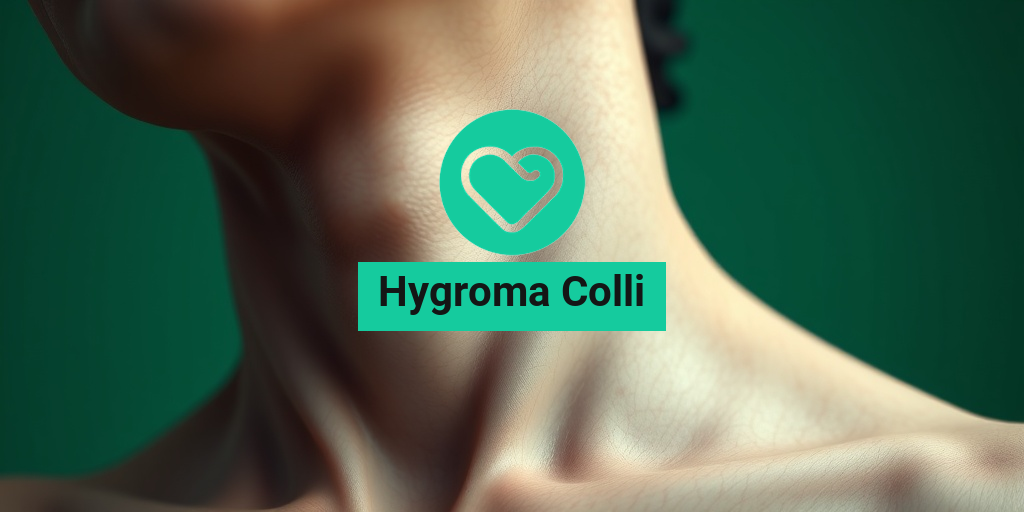What Is Hygroma Colli?
Hygroma Colli is a medical condition characterized by the presence of a fluid-filled sac, or cyst, that typically forms in the neck region, particularly in the posterior triangle. This condition is often associated with lymphatic malformations and can be congenital, meaning it is present at birth. Hygroma colli is most commonly seen in infants and young children, although it can occasionally be diagnosed in adults as well.
The term “hygroma” refers to a cystic swelling filled with lymphatic fluid, while “colli” denotes its location in the neck. These cysts can vary in size and may be soft to the touch. In some cases, they can grow large enough to cause discomfort or complications, depending on their size and location.
Causes of Hygroma Colli
The exact cause of hygroma colli is not always clear, but it is believed to arise from developmental issues in the lymphatic system. Some potential factors include:
- Genetic Factors: Certain genetic syndromes, such as Turner syndrome, are associated with an increased risk of developing hygroma colli.
- Congenital Malformations: Abnormalities in the formation of lymphatic vessels during fetal development can lead to the formation of these cysts.
- Infections: In some cases, infections during pregnancy may contribute to the development of hygroma colli.
Diagnosis of Hygroma Colli
Diagnosis typically involves a combination of physical examination and imaging studies. Ultrasound is the most common imaging technique used to visualize the cyst and assess its characteristics. In some cases, further imaging, such as MRI or CT scans, may be necessary to evaluate the extent of the condition.
Hygroma Colli Symptoms
The symptoms of hygroma colli can vary widely depending on the size and location of the cyst. Some individuals may experience no symptoms at all, while others may present with noticeable signs. Here are some common symptoms associated with hygroma colli:
Visible Swelling
The most apparent symptom is a visible swelling or lump in the neck area. This swelling may be soft and fluctuant, and it can vary in size. In infants, the cyst may be more noticeable when the child is crying or straining.
Discomfort or Pain
While many individuals with hygroma colli do not experience pain, larger cysts can cause discomfort or pain, especially if they press against surrounding structures in the neck. This discomfort may manifest as:
- Neck Pain: Discomfort in the neck region, particularly when turning the head.
- Difficulty Swallowing: In some cases, the cyst may compress the esophagus, leading to swallowing difficulties.
- Respiratory Issues: If the cyst is large enough, it may compress the trachea, causing breathing difficulties.
Associated Symptoms
In addition to the primary symptoms, hygroma colli may be associated with other conditions, particularly if it is part of a genetic syndrome. These can include:
- Cardiac Anomalies: Some individuals may have heart defects.
- Renal Issues: Kidney abnormalities may also be present.
- Growth Delays: Children with hygroma colli may experience growth delays or developmental issues.
When to Seek Medical Attention
If you or your child notice a swelling in the neck that persists or grows larger, it is essential to consult a healthcare professional. Early diagnosis and intervention can help manage the condition effectively and prevent potential complications.
For more detailed information and resources on hygroma colli, consider visiting Yesil Health AI, where you can find evidence-based health answers tailored to your needs.
In conclusion, understanding hygroma colli is crucial for early detection and management. If you suspect you or your child may have this condition, don’t hesitate to seek medical advice. Remember, knowledge is power when it comes to health! 💪

Hygroma Colli Causes
Hygroma colli is a condition characterized by the accumulation of lymphatic fluid in the neck region, often presenting as a cystic mass. Understanding the causes of hygroma colli is crucial for early diagnosis and effective management. Here, we delve into the primary causes associated with this condition.
Congenital Factors
One of the most common causes of hygroma colli is congenital abnormalities. These typically arise during fetal development and can lead to the improper formation of lymphatic vessels. Some key congenital factors include:
- Chromosomal Abnormalities: Conditions such as Turner syndrome and Down syndrome are often linked to the development of hygroma colli.
- Genetic Mutations: Certain genetic mutations can disrupt normal lymphatic development, leading to fluid accumulation.
Acquired Factors
While congenital causes are prevalent, acquired factors can also contribute to the development of hygroma colli. These may include:
- Infections: Viral or bacterial infections can lead to inflammation and obstruction of lymphatic vessels, resulting in fluid buildup.
- Trauma: Physical injury to the neck area can damage lymphatic vessels, causing lymphatic fluid to leak and form a hygroma.
Other Medical Conditions
Several medical conditions can predispose individuals to hygroma colli. These include:
- Heart Defects: Congenital heart defects can affect lymphatic drainage, leading to fluid accumulation in the neck.
- Neoplasms: Tumors in the neck region can obstruct lymphatic flow, contributing to the formation of hygromas.
Hygroma Colli Risk Factors
Identifying the risk factors associated with hygroma colli can help in early detection and intervention. While some risk factors are beyond control, others can be managed through lifestyle choices and medical care.
Genetic Predisposition
Individuals with a family history of genetic disorders are at a higher risk of developing hygroma colli. Genetic counseling may be beneficial for families with known chromosomal abnormalities, as it can provide insights into the likelihood of recurrence in future pregnancies.
Maternal Health Factors
The health of the mother during pregnancy plays a significant role in the development of hygroma colli in the fetus. Key maternal health factors include:
- Age: Advanced maternal age is associated with a higher risk of chromosomal abnormalities.
- Pre-existing Conditions: Conditions such as diabetes or autoimmune disorders can impact fetal development and increase the risk of hygroma colli.
Environmental Factors
Exposure to certain environmental factors during pregnancy may also contribute to the risk of hygroma colli. These factors include:
- Teratogens: Substances that can cause developmental abnormalities, such as certain medications, alcohol, and illicit drugs, can increase the risk.
- Infections: Maternal infections during pregnancy, such as rubella or cytomegalovirus, can lead to complications affecting fetal development.
Other Considerations
In addition to the factors mentioned above, certain lifestyle choices can influence the risk of hygroma colli:
- Smoking: Maternal smoking during pregnancy is linked to various complications, including developmental issues.
- Nutrition: A well-balanced diet is essential for fetal health; deficiencies in key nutrients can lead to developmental problems.
Understanding the causes and risk factors associated with hygroma colli is vital for expectant parents and healthcare providers. Early detection and appropriate management can significantly improve outcomes for affected individuals. If you suspect hygroma colli or have concerns about your health or that of your baby, consult a healthcare professional for guidance and support. 🩺

Hygroma Colli Diagnosis
Diagnosing hygroma colli can be a complex process, as it often requires a combination of clinical evaluation and imaging studies. This condition, characterized by a fluid-filled cystic mass typically located in the neck region, can be detected at various stages of life, including during pregnancy or shortly after birth.
Clinical Evaluation
The first step in diagnosing hygroma colli usually involves a thorough clinical evaluation. Healthcare providers will assess the patient’s medical history and perform a physical examination. Key indicators may include:
- Visible Swelling: A noticeable lump or swelling in the neck area.
- Symptoms: Any associated symptoms such as difficulty breathing or swallowing.
- Family History: A history of similar conditions in the family may also be relevant.
Imaging Studies
Once a physical examination suggests the presence of hygroma colli, imaging studies are typically employed to confirm the diagnosis. The most common imaging techniques include:
- Ultrasound: This is often the first imaging modality used, especially in prenatal cases. An ultrasound can help visualize the cystic structure and assess its size and location.
- Magnetic Resonance Imaging (MRI): MRI provides detailed images of soft tissues and can help differentiate hygroma colli from other neck masses.
- Computed Tomography (CT) Scan: A CT scan may be used in certain cases to provide a more comprehensive view of the neck anatomy.
In some instances, further tests may be necessary to rule out associated conditions or complications. For example, genetic testing may be recommended if there is a suspicion of chromosomal abnormalities linked to the hygroma colli.
Hygroma Colli Treatment Options
Treatment for hygroma colli varies depending on several factors, including the size of the cyst, the age of the patient, and any associated symptoms or complications. Here are the primary treatment options available:
Observation
In cases where the hygroma colli is small and asymptomatic, a “watchful waiting” approach may be adopted. Regular monitoring through follow-up ultrasounds can help track any changes in size or symptoms. This is particularly common in prenatal cases where the cyst may resolve on its own.
Drainage Procedures
If the hygroma colli is large or causing discomfort, a healthcare provider may recommend a drainage procedure. This involves:
- Needle Aspiration: A thin needle is inserted into the cyst to remove the fluid. This can provide immediate relief and may reduce the size of the hygroma.
- Shunt Placement: In some cases, a shunt may be placed to allow continuous drainage of fluid, especially if the hygroma is recurrent.
Surgical Intervention
For larger or symptomatic hygromas, surgical intervention may be necessary. Surgical options include:
- Excision: The cyst can be surgically removed, which may provide a permanent solution.
- Reconstruction: If the hygroma colli has caused significant structural changes in the neck, reconstructive surgery may be needed to restore normal anatomy.
Post-Treatment Care
After treatment, follow-up care is crucial to monitor for any recurrence of the hygroma colli. Patients may need:
- Regular Check-Ups: Scheduled visits to assess healing and detect any potential complications.
- Physical Therapy: In some cases, physical therapy may be recommended to improve neck mobility and strength.
Overall, the prognosis for individuals with hygroma colli is generally positive, especially with timely diagnosis and appropriate treatment. If you suspect you or someone you know may have this condition, it’s essential to consult a healthcare professional for a comprehensive evaluation and personalized treatment plan. 🩺

Hygroma Colli Home Remedies
Hygroma colli, also known as a cystic hygroma, is a fluid-filled sac that typically appears in the neck region, often seen in newborns and fetuses. While medical intervention is often necessary, some home remedies may help manage symptoms and support overall health. Here are some effective home remedies to consider:
1. Warm Compresses
Applying a warm compress to the affected area can help reduce discomfort and promote circulation. Simply soak a clean cloth in warm water, wring it out, and place it gently on the hygroma for 15-20 minutes. This can help alleviate swelling and provide some relief.
2. Herbal Remedies
Some herbs are known for their anti-inflammatory properties. Consider using:
- Turmeric: Known for its powerful anti-inflammatory effects, turmeric can be consumed in food or as a supplement.
- Ginger: Another anti-inflammatory herb, ginger can be made into tea or added to meals.
Always consult with a healthcare provider before starting any herbal regimen, especially for children or pregnant women.
3. Dietary Adjustments
Maintaining a healthy diet can support the body’s healing processes. Focus on:
- Fruits and Vegetables: Rich in vitamins and antioxidants, these foods can help reduce inflammation.
- Omega-3 Fatty Acids: Found in fish, flaxseeds, and walnuts, omega-3s are known for their anti-inflammatory properties.
4. Hydration
Staying well-hydrated is crucial for overall health. Drinking plenty of water can help flush out toxins and support the body’s natural healing processes. Aim for at least 8 glasses of water a day, or more if you are active or live in a hot climate.
5. Gentle Massage
If approved by a healthcare professional, gentle massage around the area may help improve circulation and reduce discomfort. Use light pressure and avoid any painful areas. Always consult with a doctor before trying this remedy, especially for children.
Hygroma Colli Prognosis
The prognosis for individuals with hygroma colli can vary significantly based on several factors, including the size of the hygroma, the age of the patient, and any associated conditions. Understanding the potential outcomes can help families prepare for what lies ahead.
1. Factors Influencing Prognosis
Several factors can influence the prognosis of hygroma colli:
- Size of the Hygroma: Smaller hygromas may resolve on their own, while larger ones may require medical intervention.
- Associated Anomalies: Hygromas can sometimes be associated with other congenital anomalies, which can affect overall health and prognosis.
- Age of Diagnosis: Early detection and treatment can lead to better outcomes.
2. Treatment Options
Treatment for hygroma colli may include:
- Observation: In some cases, especially with smaller hygromas, doctors may recommend monitoring the condition without immediate intervention.
- Surgical Removal: Larger hygromas or those causing significant symptoms may require surgical intervention to remove the cyst.
- Drainage: In certain cases, draining the fluid from the hygroma can provide relief and improve symptoms.
3. Long-Term Outlook
With appropriate treatment, many individuals with hygroma colli can expect a positive outcome. Regular follow-ups with healthcare providers are essential to monitor the condition and address any complications that may arise. Early intervention often leads to better results, so seeking medical advice promptly is crucial.
In conclusion, while hygroma colli can be concerning, understanding home remedies and the prognosis can empower families to make informed decisions about care and treatment. Always consult with healthcare professionals for personalized advice and treatment options. 🌟

Frequently Asked Questions about Hygroma Colli
What is Hygroma Colli?
Hygroma Colli is a type of cystic swelling that typically occurs in the neck region, often associated with lymphatic malformations. It is most commonly seen in infants and can vary in size and severity.
What causes Hygroma Colli?
The exact cause of Hygroma Colli is not fully understood, but it is believed to result from developmental abnormalities in the lymphatic system. Genetic factors may also play a role in its occurrence.
How is Hygroma Colli diagnosed?
Diagnosis of Hygroma Colli is usually made through imaging techniques such as ultrasound, which can help visualize the cystic structure. In some cases, further imaging or genetic testing may be recommended.
What are the symptoms of Hygroma Colli?
Symptoms can vary, but common signs include:
- Swelling in the neck area
- Difficulty breathing or swallowing (in severe cases)
- Visible mass or lump
What is the treatment for Hygroma Colli?
Treatment options for Hygroma Colli may include:
- Observation for smaller, asymptomatic cases
- Surgical removal for larger or symptomatic cysts
- Drainage procedures in certain situations
Is Hygroma Colli hereditary?
While Hygroma Colli is not directly inherited, certain genetic conditions may increase the likelihood of its occurrence. It is advisable to consult with a genetic counselor if there is a family history of lymphatic malformations.
What is the ICD-10 code for Hygroma Colli?
The ICD-10 code for Hygroma Colli is Q82.8, which falls under the category of other specified congenital malformations of the skin.
Can Hygroma Colli occur during pregnancy?
Yes, Hygroma Colli can be detected during pregnancy through routine ultrasounds. It is important for expectant parents to discuss any findings with their healthcare provider for further evaluation and management.
Where can I find more information about Hygroma Colli?
For more detailed information, you can refer to medical literature, research articles, or consult healthcare professionals. Resources like the NCBI (National Center for Biotechnology Information) may also provide valuable insights.




